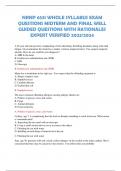Resume
Volledige samenvatting Marketing Mix Management - Deel Consumer Behaviour Towards The Marketing Mix KULeuven MBA ()
- Cours
- Marketing Mix Management
- Établissement
- Katholieke Universiteit Leuven (KU Leuven)
Volledige samenvatting van Marketing Mix Management - Consumer Behaviour Towards The Marketing Mix gegeven door T. De Bock. De samenvatting bevat alle slides uit de les aangevuld met eigen notities.
[Montrer plus]












